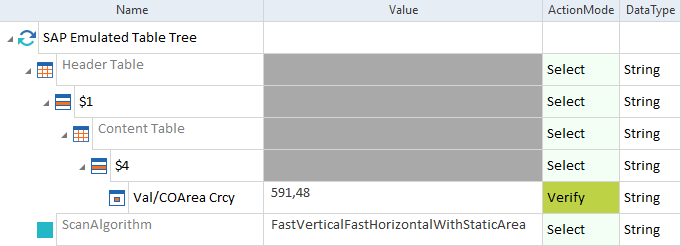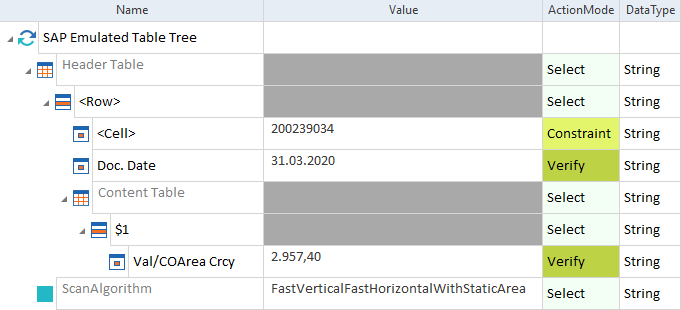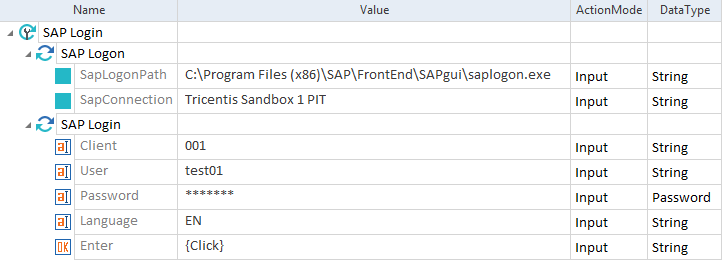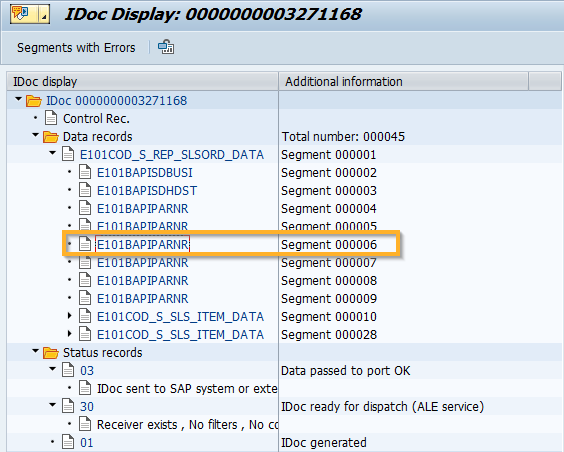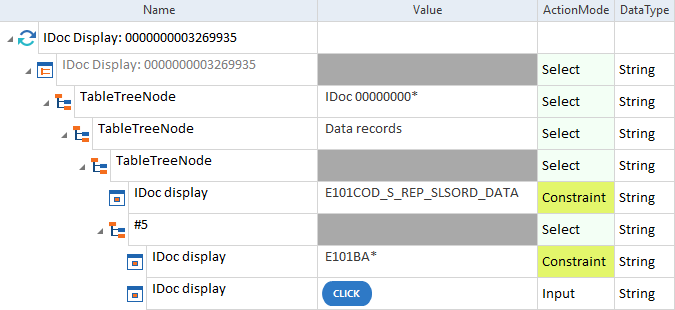Steer SAP controls
With the SAP Engine 3.0, you can steer controls in SAP.
The table below lists all SAP controls that you can steer.
|
Name of SAP controls |
Identified in XScan as |
Standard Module |
|---|---|---|
|
|
■ |
|
|
|
■ |
|
|
|
■ |
|
|
|
■ |
|
|
■ |
||
|
■ |
||
|
■ |
||
|
|
■ |
|
|
■ |
||
|
■ |
||
|
■ |
||
|
■ |
||
|
|
■ |
|
|
|
■ |
|
|
■ |
||
|
■ |
||
|
|
■ |
|
|
|
■ |
|
|
■ |
||
|
|
SAP Calendar
The SAP Calendar control allows you to select a date, range of dates, or a week from the SAP Calendar. You can scan the SAP calendar control with XScan.
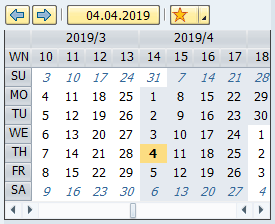
SAP calendar control
To scan and steer this control, follow the steps below:
-
Create a TestCase with the scanned Module.
-
Set the ActionMode of the calendar control to Input.

SAP Calendar Module in a TestCase
-
In the Value field, insert the correct date format as described in the table below.
|
Date format |
Description |
Example |
|---|---|---|
|
yyyyMMdd |
Enter the year, the month, and the day to select a specific day in the calendar. |
20190430 |
|
yyyyMMdd-yyyyMMdd |
Enter the start date and end date to select a range of dates in the calendar. |
20190401-20190430 |
|
CWxx/yyyy |
Enter CW followed by the week number and the year to select a specific week in the calendar. |
CW12/2019 |
SAP ComboBox
The ComboBox control allows you to select an item from a predefined drop-down list. A ComboBox item is an entry in the drop-down list. You can steer ComboBoxes as described in chapter "ComboBox".
In SAP, every ComboBox item has a key and a value:
-
A key can consists of letters and numbers.
-
A value is the text of the item.
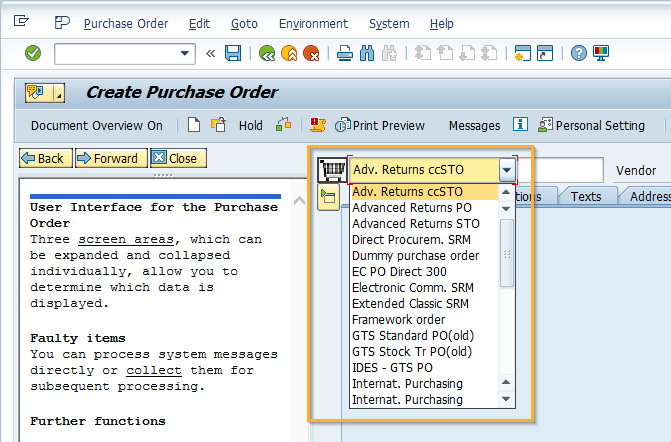
Values in a ComboBox
By default, SAP GUI displays only values. However, you can enable displaying both keys and values.
Alternatively, you can enable Tricentis Tosca to identify ComboBox items by both keys and values.

Keys and values in a ComboBox
To display keys in SAP GUI, follow the steps below:
-
In SAP GUI, click the Customize Local Layout icon and select Options... from the context menu.
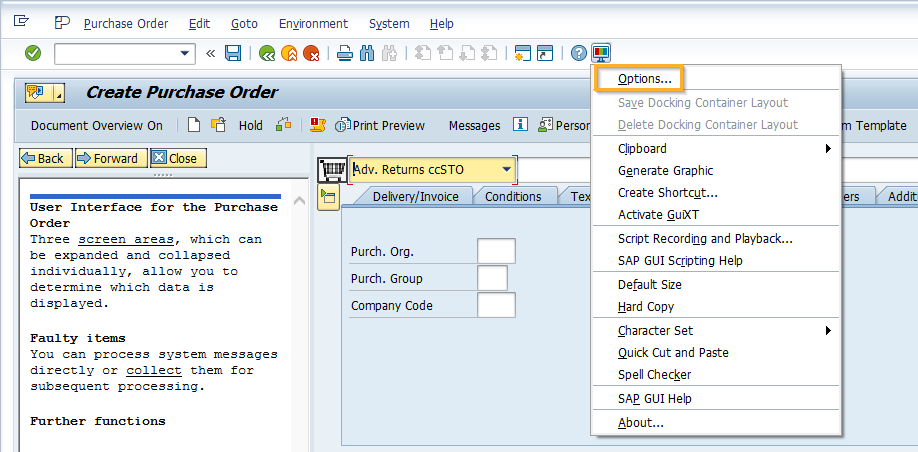
Customize Local Layout context menu
-
In the Options screen, go to Interactive Design->Visualization 1->Controls.
-
In the Controls area, select the check box Show keys within dropdown lists.

Show keys within dropdown list check box in SAP GUI
Enable Tricentis Tosca to identify ComboBox items by keys and values
When you scan an SAP ComboBox, Tricentis Tosca identifies ComboBox items by their values by default. ComboBox items can share the same value, which makes it impossible to uniquely identify the values. You can make ComboBox items identifiable by both keys and values in Tosca Commander. This setting works regardless of whether keys are displayed in SAP GUI or not.
To identify ComboBox by both keys and values, follow the steps below:
-
In Tosca Commander, go to Projects->Settings.
-
In Tosca Settings, go to Settings->TBox->Engines->SAP.
-
Click the Combobox items selectable by its Key row.
-
Select True from the drop-down list in the Value column.
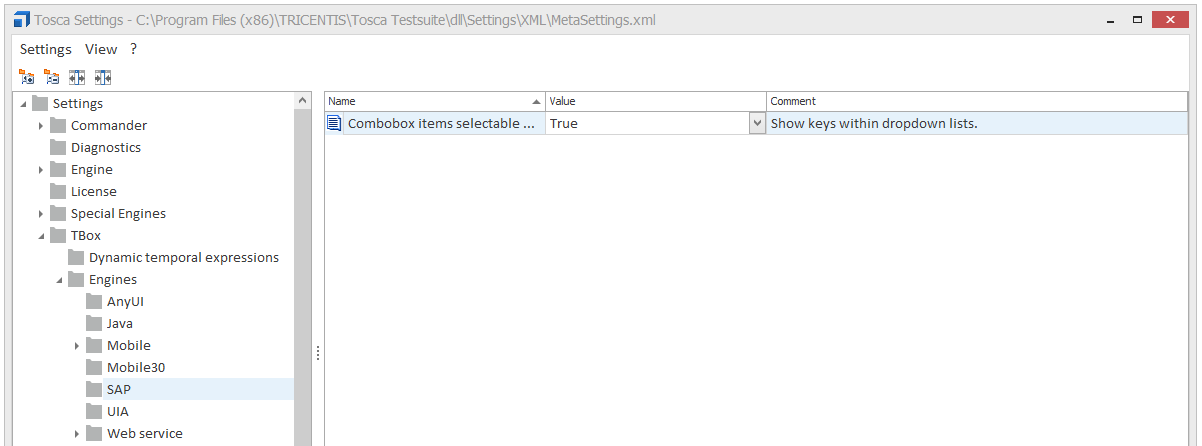
Enable Tricentis Tosca to identify ComboBoxes by both keys and values
When you scan a ComboBox, Tricentis Tosca now shows items in TestCases with both keys and values.
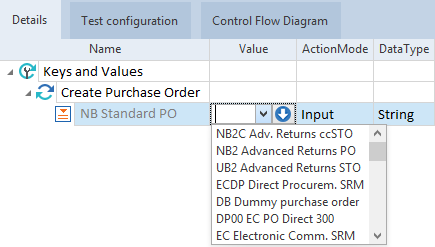
Keys and values in the Value field

|
If you enable this option in Tosca Commander and create Modules with ComboBoxes, the TestCases which use these Modules only work properly if this option remains enabled. If you disable it, you need to rescan the Modules. However, changing this setting in SAP doesn't influence Modules in Tricentis Tosca. |
SAP ContextMenu
To steer SAP context menus, use the Module SAP ContextMenu.
This Module is part of the Standard subset. You can find it under Standard modules->TBox XEngines->Sap.
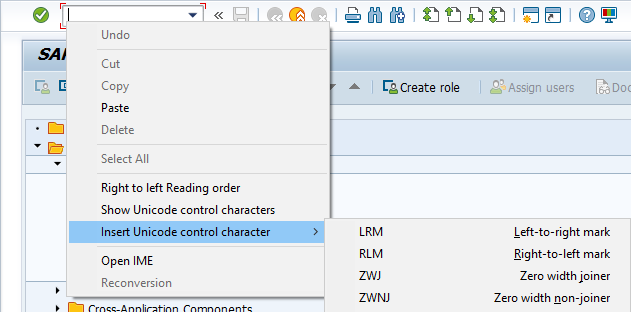
SAP context menu

|
Context menus must be open for the SAP Engine 3.0 to steer them. Use image-based test automation to open context menus in trees. |

|
In this example, the SAP Engine 3.0 opens the context menu and selects the entry Insert Unicode control character->Zero width joiner.
SAP context menu: specify the menu path |

|
In this example, the SAP Engine 3.0 opens the context menu and verifies whether the option Zero width joiner exists.
Verify SAP context menu entries |
SAP Emulated Tree
To steer SAP Emulated Tree, use the Module SAP Emulated Tree.
This Module is part of the Standard subset. You can find it under Standard modules->TBox XEngines->Sap.

|
In this example, you want to click on the entry BAPISDBUSI in the following Emulated Tree:
Emulated Table Tree in SAP To do so, you use the Module SAP Emulated Tree and enter the following TestStepValues:
SAP Emulated Tree Module in a TestCase |

|
In this example, you want to verify if the traffic light in Other Objects is set to Red.
Emulated Tree in SAP To do so, you use the Module SAP Emulated Tree and enter the following TestStepValues:
SAP Emulated Tree Module in a TestCase |
SAP Emulated Table Tree
To steer SAP Emulated Table Tree, use the Module SAP Emulated Table Tree.
This Module is part of the Standard subset. You can find it under Standard modules->TBox XEngines->Sap.

Emulated Table Tree in SAP
SAP Emulated Table Tree consists of the following elements:
-
The main table with expandable rows. The header with column names of this table is at the top. Each corresponding row is marked with the icon
 Detail can be Expanded. In SAP, both the header and the rows of the main table are marked with an orange color. In the Module SAP Emulated Table Tree, it's represented by Header Table.
Detail can be Expanded. In SAP, both the header and the rows of the main table are marked with an orange color. In the Module SAP Emulated Table Tree, it's represented by Header Table. -
The embedded table. The header with column names of this table is under the header of the main table. In SAP, it's marked with a blue color. The content of this table is visible when you expand the rows of the main table. In SAP, the content area of the embedded table is white. In the Module SAP Emulated Table Tree, it's represented by Content Table.

|
In this example, you want to verify if the value of the cell marked on the following screenshot is 591,48:
Emulated Table Tree in SAP To do so, you use the Module SAP Emulated Table Tree and enter the following TestStepValues:
SAP Emulated Table Tree Module in a TestCase |

|
In this example, you want to verify the following values in an Emulated Table Tree:
Emulated Table Tree in SAP To do so, you use the Module SAP Emulated Table Tree and enter the following TestStepValues:
SAP Emulated Table Tree Module in a TestCase |
SAP Login
To enter user data into the SAP Login screen, use the Module SAP Login.
This Module is part of the Standard subset. You can find it under Standard modules->TBox XEngines->Sap.
To sign in to SAP with the Module SAP Login, follow the steps below:
-
Launch the SAP system with the Module SAP Logon.
This step is a mandatory first step if you want to steer the SAP Login screen.
-
Create a new TestStep out of the Module SAP Login to enter the required user data.

|
In this example, you sign in to Client 001 with the user credentials of the user test01.
Open the SAP system, then steer the Login screen |
SAP Logon
To steer the SAP Logon window, use the Module SAP Logon.
This Module is part of the Standard subset. You can find it under Standard modules->TBox XEngines->Sap.

|
In this example, you open the SAP Logon dialog using the connection name.
Open an SAP connection using the connection name |

|
In this example, you open the SAP Logon dialog using the SID.
Open an SAP connection using the SID |
SAP Menu
To steer SAP menus, use the Module SAP Menu.
This Module is part of the Standard subset. You can find it under Standard modules->TBox XEngines->Sap.

|
In this example, you select the menu entry QuickViewer by entering the path System->Services->QuickViewer.
SAP menu: use the menu path |

|
In this example, you directly select the menu entry QuickViewer.
SAP menu: use the menu entry directly |

|
In this example, the SAP Engine 3.0 verifies that the menu entry System->Services->QuickViewer exists.
SAP menu: verify that the menu entry QuickViewer exists |
SAP Multiple Logon
To steer the modal dialog window License Information for Multiple Logon, use the Module SAP Multiple Logon License Warning.
This Module is part of the Standard subset. You can find it under Standard modules->TBox XEngines->Sap.
The modal dialog box License Information for Multiple Logon opens if a user attempts to sign in to the system several times.
You can define the caption of the dialog box in the Properties tab of the Module. To do so, enter the respective Value for the parameter CaptionList. To enter the caption in multiple languages, separate them with semicolons.

|
In this example, the SAP Engine 3.0 performs the following actions:
Steer the License Information for Multiple Logon dialog box |
SAP SpecialToolbar
SAP SpecialToolbar is a toolbar with buttons that open context menus.
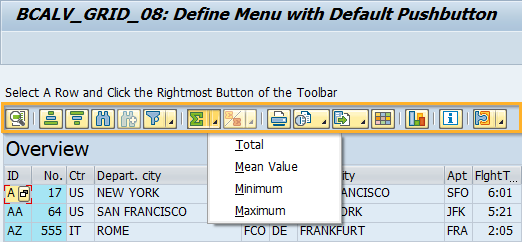
Context menu of the Total toolbar button
Follow the instructions in this chapter to:
To scan SAP SpecialToolbar, follow the steps below:
-
Run XScan and select the SAP window you want to scan.
-
If you use the Basic View or the Condensed View in XScan, right-click the table grid and select Toolbar from the context menu. This enables you to scan a toolbar independently from its table grid.
If you use the Advanced View in XScan, you must enable the Select on screen option first.
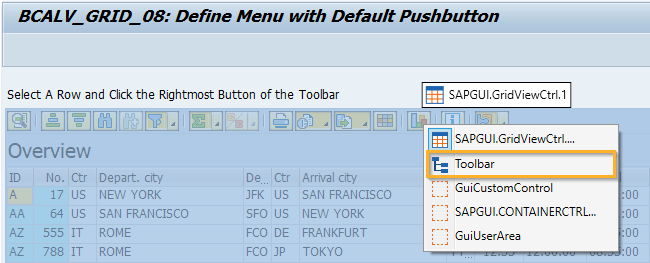
Select on Screen context menu options
-
Save the Module or continue to scan other screens as described in chapter "Select controls in the test object".
To steer SAP SpecialToolbar, follow the steps below:
-
Create a TestCase with the scanned module.
-
In the Value field of the Toolbar control, select the context menu item you want to steer.
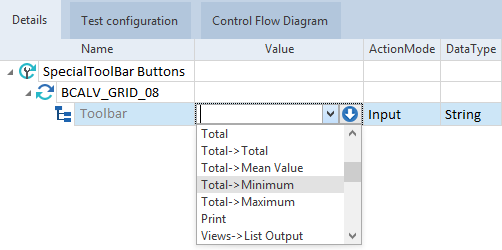
Toolbar control in the TestStep
-
Set the ActionMode to Input.
SAP Status Bar
To verify information on the SAP Status Bar as well as various session information, use the Module SAP Statusbar.
This Module is part of the Standard subset. You can find it under Standard modules->TBox XEngines->Sap.

SAP Status Bar

|
In this example, you verify whether the type of the status bar message is Success.
Verify SAP Status Bar - MessageType |
Scan SAP Status Bars
You can scan the SAP Status Bar with Tosca XScan. For detailed information on scanning Modules with Tosca XScan, see chapter "Scan Modules".
You can verify the following properties via the Value column:
|
Property |
Description |
|---|---|
|
Message |
Verifies the text of the status bar message. |
|
MessageType |
Verifies the type of the status bar message. You can use the following values:
|

|
In this example, you use the property Message to verify whether the text of the status bar message is Transaction.
Verify SAP Status Bar - Message |
SAP SubToolbar
To steer SAP SubToolbars, use the Module SAP SubToolbar.
This Module is part of the Standard subset. You can find it under Standard modules->TBox XEngines->Sap.
Alternatively, you can also scan SAP SubToolBars with XScan.

SAP SubToolbar
Define the tooltip text of the SubToolbar button you want to click via the parameter SubToolBar.

|
If a tool-tip text of a SubToolbar button contains nodes ->, Tricentis Tosca recognizes it as an entry path. To change this behavior, you can use wildcard characters *.
Label that contains nodes
Wildcard characters in SAP SubToolBar TestStep |

|
In this example, the SAP Engine 3.0 steers the Create role button in the SAP SubToolbar.
Steer an SAP SubToolbar |
SAP Table
You can scan SAP tables and SAP grid views with XScan, and steer them as described in chapter "Table".
If one control is defined in a cell, you can steer it. If more than one control is defined, you can embed the controls in the cell of a table. For detailed information on defining controls in cells, see chapter "Defining controls in cells".

SAP Table
Tricentis Tosca supports the following click operations along with the ActionMode Input:
|
Click operation |
Description |
|---|---|
|
{SELECT} |
Selects the specified row, column, or table. |
|
{ADDSELECT} |
Selects the specified row or column while any existing selections remain unchanged. |
|
{DESELECT} |
Deselects the specified row or column while any existing selections remain unchanged. |

|
In the example below, you select the second row of the Project Overview table.
Select a table row |
Tricentis Tosca supports the selection of a whole SAP table or grid view, when the SAP Toolbar provides the function Select All.

SAP Table Toolbar: Select All

|
In the example below, you select the whole table Content Repository.
Select the whole table |
Verify the traffic light value of a node
Tables may include a traffic light status that you can verify with the ActionMode Verify. To do so, follow the steps below:
-
Create a TrafficLight control in the Module as described in chapter "Defining controls in cells".
-
Select the traffic light color to be verified in the corresponding TestStepValue.
The following values are possible: Green, Yellow, Red.
-
Set the ActionMode to Verify.

|
In this example, you verify whether the traffic light value of the first data row is Green.
Traffic light status in SAP
Verify the traffic light status |
SAP TableTree
You can scan SAP TableTrees with XScan.

SAP TableTree
You can steer the respective entries in the following ways:
-
Specify a path.
-
Select the items directly via the tree items.
To steer the table tree, set the ActionMode to Select for the TableTree control. If you enter the path, separate the nodes with ->. If you select the items directly, you must use the ActionMode Select for all items that are located hierarchically above the selected item.
To select the cell of a TableTree item, enter the name of its column into the Name column.
To steer controls within cells, you have to create embedded controls (see chapter "Defining controls in cells").

|
In the example below, Tricentis Tosca selects the entry Workbench Demos->Controls->Picture Controls->Screen display and buffers the value of the cell in the column Report/Transaction into the buffer ColumnName.
Buffer a TableTree entry
Buffer a TableTree entry via the path |

|
In some transactions, for example WE02 and WE05, the TableTree contains underlying nodes, which are additional nodes inside a TableTree node.
TableTree with underlying nodes in SAP In this example, you want to steer an element of a TableTree that contains underlying nodes. To do so, follow the steps below:
Steer TableTree with underlying nodes |
When you use the ActionMode Constraint on a TableTree, Tricentis recommends that you use the $ sign to define a parameter such as a ColumnName or ColumnNumber.
If you use the # sign, Tricentis Tosca only returns the occurrence which matches the ordinal number specified.
For instance, #3 returns only the third occurrence of cells containing this parameter. $3 returns the first, second and third occurrences of cells that contain the parameter.
Copy cell paths from Content View in XScan
You can copy cell paths for SAP TableTrees to simplify the creation of TestCases. To do so, follow the steps below:
-
Scan the TableTree with XScan.
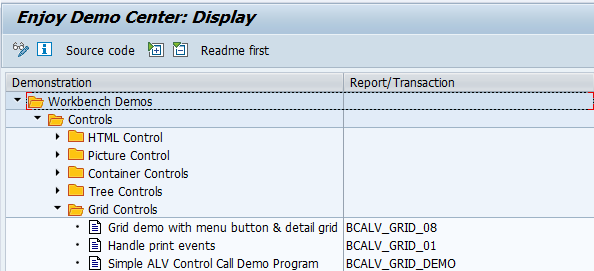
SAP TableTree
You can now view the cell path of the TableTree in Content View.
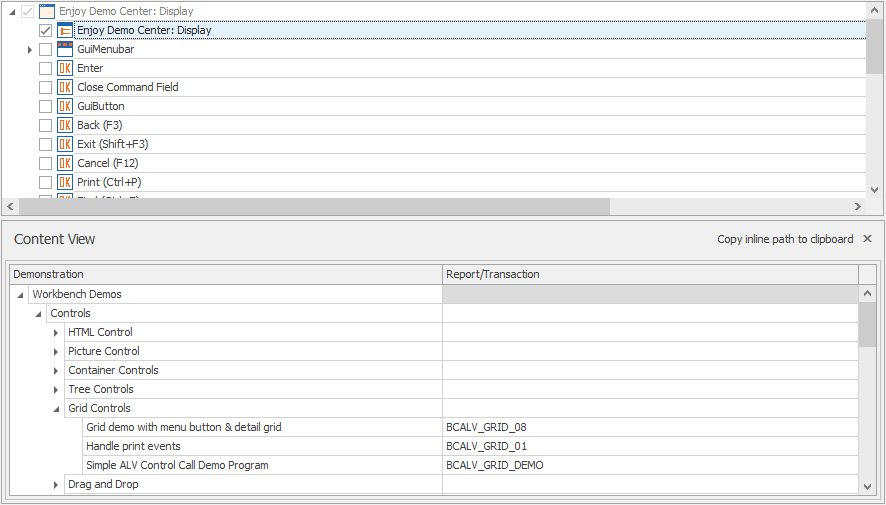
Copy inline path to clipboard option in Content View
-
In Content View, click on Copy inline path to clipboard.
-
In the subsequent dialog window, click OK.

Notification message in XScan
-
Paste the cell path into your TestStep.

Cell path in a TestStep
Verify the traffic light value of a node
SAP TableTrees may include a traffic light status that you can verify with the ActionMode Verify. To do so, follow the steps below:
-
Create a TrafficLight control in the Module as described in chapter "Defining controls in cells".
-
Select the traffic light color to be verified in the corresponding TestStepValue.
The following values are possible: Green, Yellow, Red.
-
Set the ActionMode to Verify.
Identify columns by the name
You can identify a column of a TableTree via its name instead of its caption. To do so, use the steering parameter IdentifyColumnsByName.
The steering parameter is created when you scan the control. You can edit it via the XScan Identify By Properties grid in the Steering section.
To steer columns by their name instead of their caption, you must set the steering parameter to True.
SAP Toolbar
To steer an SAP Toolbar that contains the transaction code field, use the Module SAP Toolbar.
This Module is part of the Standard subset. You can find it under Standard modules->TBox XEngines->Sap.

SAP Toolbar with transaction code field
You can also scan and steer SAP Toolbars that contain context menus. To do so, follow the steps described in chapter "SAP SpecialToolbar".

|
In this example, you search for transaction code RZ11.
Search for a transaction code |
SAP TreeView
To steer SAP TreeViews, use the Module SAP TreeView.
This Module is part of the Standard subset. You can find it under Standard modules->TBox XEngines->Sap.
You can also scan SAP TreeViews with Tosca XScan.

SAP TreeView

|
In this example, the SAP Engine 3.0 opens the menu entry SDCCN - Service Data Control Center via double-click.
Steer SAP TreeView |







